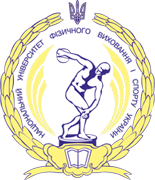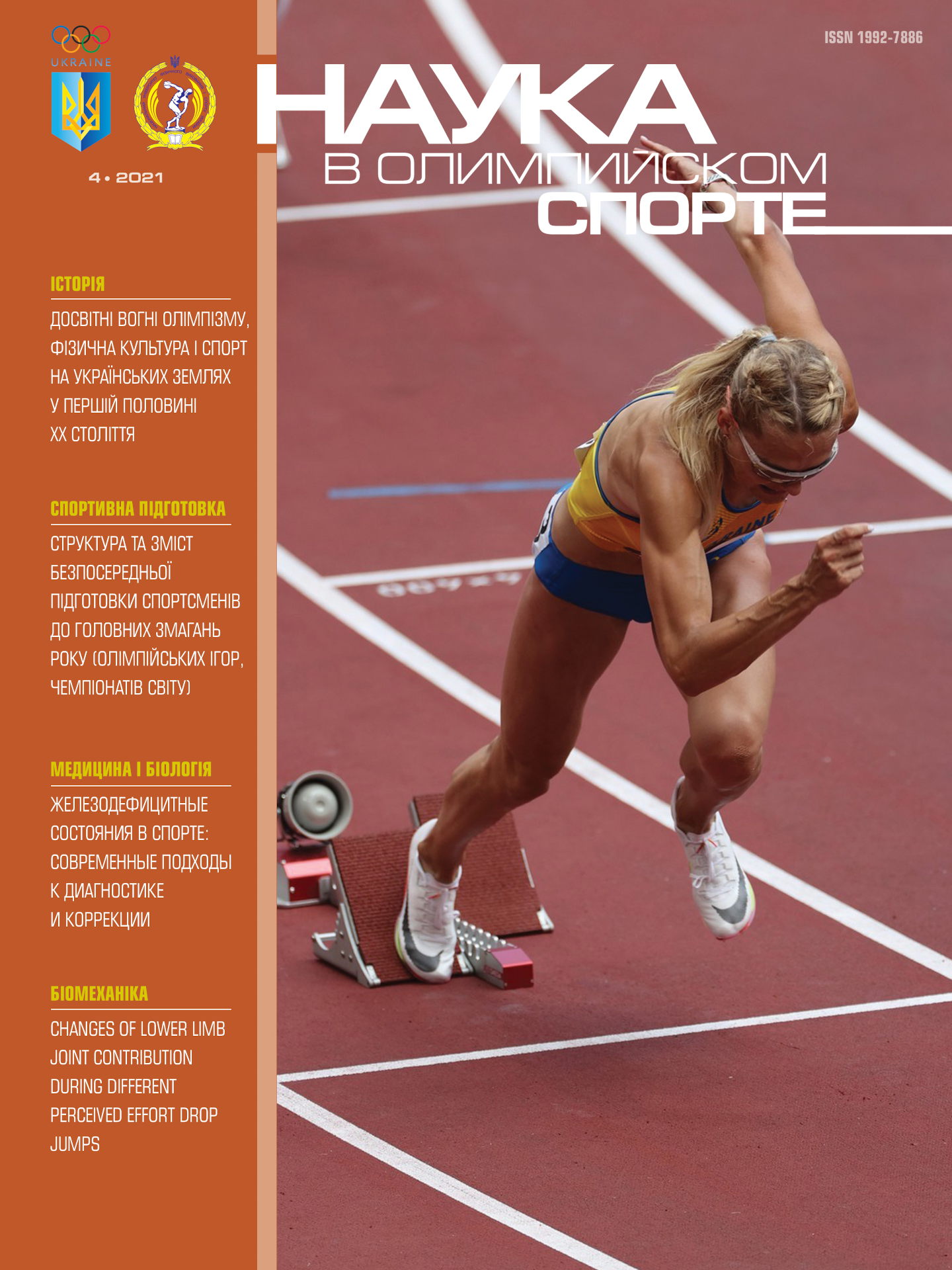doi: 10.32652/olympic2020.4_3
The article deals with the problems of sports selection of promising children for practicing track and field in the CYSS. The results of a longitudinal study of sprinters in the age range of 12-17 years are presented. The author's complex methodology for predicting the motor abilities of young sprinters was used. A comprehensive method for predicting the motor abilities of sprinters at the stage of initial sports specialization consisting of three components was developed with account for the most informative indices that determine the prospects of young athletes. The first component is a complex testing of young sprinters using the most informative indices that determine the level of prospects. Testing is carried out in three stages (at the beginning of the preparatory period, during the second competitive period of athletes of the 1st year of training, and during the second competitive period of athletes of the 2nd year of training); the second component - assessment of prospects (preliminary, intermediate, final), calculated in points using the developed formulas; the third component - selection into training groups based on the assessment of the prospects of athletes (differentiation is carried out in training groups, identifying the potential and forecasting the motor abilities of sprinters, staffing training groups). The results of the pedagogical experiment showed the effectiveness of this methodology. It is noted that an objective assessment of the prospects of young athletes can be obtained only on the basis of complex studies. The developed methodology may be modified later on. However, there is reason to believe that the general nature of the research has already allowed obtaining objective data, on the basis of which an attempt was made to equip practitioners of physical culture and sports with a comprehensive method of predicting motor abilities of sprinters at the stage of initial sports specialization with account for the most informative indices that determine the prospects of young athletes.
Literature:
1. Akimova LN. Psikhologiya sporta [Sports psychology]. Odessa: Studiya «Negotsiant»; 2004. 127 s.
2. Alabin VG, Alabin AV, Bizin VP. Mnogoletnyaya trenirovka yunykh sportsmenov [Long-term training of young athletes]. Khar'kov: OSNOVA; 1993. 243 s.
3. Afanas'yeva IA. Sportivnyy otbor taekvondistov s uchetom ikh geneticheskikh osobennostey treniruyemosti: dis. kand. ped. nauk. [Sports selection of taekwondo athletes taking into account their genetic characteristics of training]. 13.00.04. Sankt-Peterburg, 2002. 141 s.
4. Akhatov AM, Kuznetsov AS. Osnovnyye napravleniya otbora i oriyentatsii, ispol'zuyemyye v detsko-yunosheskom sporte [General selection and orientation directions used in children's and youth sports]. Naberezhnyye Chelny: KamGAFKSiT; 2010. 34 s.
5. Akhmetov II. Molekulyarnaya genetika sporta [Molecular genetics of sports]. Moskva: Sovetskiy sport; 2009. 268 s.
6. Baranayev YUA. Faktory, sposobstvuyushchiye privlecheniyu detey dlya zanyatiy legkoy atletikoy [Factors that can promote the involvement of children in track and field athletics]. Vestnik Polotskogo gosudarstvennogo universiteta. Seriya Ye. Pedagogicheskiye nauki. 2009; 5:128–30
7. Baranayev YUA. Kompleksnaya metodika otsenki dvigatel'nykh sposobnostey detey dlya zanyatiy legkoy atletikoy na nachal'nykh etapakh mnogoletney trenirovki (na primere bega na korotkiye distantsii) [A complex methodology for evaluating children's motor abilities for athletics at the primary stages of a long-term training session (using short distance running as an example)]. Vestnik Vitebskogo gosudarstvennogo universiteta. 2015; 1 (85): 62–71
8. Baranayev YUA. Otsenka individual'nykh sposobnostey legkoatletov [Evaluation of individual abilities of athletes]. Vestnik Polotskogo gosudarstvennogo universiteta. Seriya Ye. Pedagogicheskiye nauki. 2008; 5:121–4
9. Baranayev YUA. Prognosticheskaya znachimost' pokazateley fizicheskogo razvitiya, dvigatel'noy podgotovlennosti, psikhofiziologicheskogo testirovaniya i dermatoglifiki u legkoatletov na etape nachal'noy sportivnoy spetsializatsii [Prognostic importance of indices of physical development, motor fitness, psychophysiological testing and dermatoglyphics in track and field athletes at the stage of initial sports specialization]. Vestnik Polotskogo gosudarstvennogo universiteta. Seriya Ye. Pedagogicheskiye nauki.; 2010. 5:109–15
10. Bashkirov PN. Ucheniye o fizicheskom razvitii cheloveka [Teaching about human physical development]. Moskva; 1962. 339 s
11. Bulgakova NZH. Otbor i podgotovka yunykh plovtsov [Selection and training of young swimmers]. Moskva: Fizkul'tura i sport; 1986. 156 s
12. Volkov VM. Longitudinal'nyye issledovaniya skorostno-silovykh pokazateley shkol'nikov 11–14 let [Longitudinal studies of speed-strength indices of schoolchildren aged 11-14 years]. Teoriya i praktika fizicheskoy kul'tury. 1998; 7: 5-6
13. Guba VP, Val'f MV, Nikitushkin VN. Sovremennyye problemy ranney sportivnoy oriyentatsii [Modern problems of early sports orientation]. Moskva: IKA; 1998. 68 s
14. Zhetesova GS. Osnovy kvalimetrii [Basics of Qualimetry]. Karaganda: KarGTU; 2003. 65 s
15. Loskutova TD. Vremya reaktsii kak psikhofiziologicheskiy metod otsenki funktsional'nogo sostoyaniya tsentral'noy nervnoy sistemy [Response time as a psychophysiological method to assess the functional state of the central nervous system]. Neyrofiziologicheskiye issledovaniya v ekspertize trudosposobnosti. L., 1978. Gl. 6; 165-93
16. Ozolin ES. Puti privlecheniya detey k trenirovkam i sokhraneniya ikh v sportivnykh sektsiyakh [Ways to involve children in training and keep them in sports sections]. Fizicheskaya kul'tura: vospitaniye, obrazovaniye, trenirovka. 2004; 3: 32-6
17. Platonov VN. Sistema podgotovki sportsmenov v olimpiyskom sporte. Obshchaya teoriya i yeye prakticheskiye prilozheniya [System of training athletes in Olympic sport. General theory and its practical applications]. Kiyev: Olimpiyskaya literatura; 2004. 808 s
18. Sal'nikov VA. Talant, odarennost' i sposobnosti v strukture sportivnoy deyatel'nosti [Talent, genius and abilities in the structure of sports activity] Teoriya i praktika fizicheskoy kul'tury. 2002; 4:16-20
19. Semenov LA. Opredeleniye sportivnoy prigodnosti detey i podrostkov: biologicheskiye i psikhologo-pedagogicheskiye aspekty [Identifying the sports suitability of children and adolescents: biological and psychological and pedagogical aspects]. Moskva: Sovetskiy sport, 2005. 142 s
20. Siris PZ, Gaydarska PM, Rachev KI. Otbor i prognozirovaniye sposobnostey v legkoy atletike [Selecting and predicting abilities in athletics]. Moskva: Fizkul'tura i sport; 1983. 103 s
21. Filin VP. Osnovy yunosheskogo sporta [Fundamentals of youth sport]. Moskva: Fizkul'tura i sport; 1987. 130 s
22. Kharitonova LG, Gorskaya IYU. Opredeleniye khronologicheskogo, biologicheskogo vozrasta i morfotipa u detey i podrostkov [Determination of chronological, biological age and morphotype in children and adolescents]. Omsk: SibGaFK; 1997. 26 s
23. Chernukhina OV. Otbor, sokhranyayushchiy detey v sporte (na primere zhenskoy sportivnoy gimnastiki) [Selection that preserves children in sports (on the example of female gymnastics)]. Fizicheskaya kul'tura: vospitaniye, obrazovaniye, trenirovka. 2004; 1: 37-9
24. Yushkevich TP., Yuskovets YEI. Kontseptsiya kompleksnoy metodiki otbora perspektivnykh begunov na dlinnyye distantsii [The concept of a complex methodology for selecting promising long-distance runners]. Izvestiya Tul'skogo gosudarstvennogo universiteta. Fizicheskaya kul'tura. Sport. Tula: Izdatel'stvo TulGU, 2018; 2: 175-84
25. Yushkevich T.P., Baranayev YU.A. Problemy razvitiya Belorusskoy legkoy atletiki v usloviyakh ekonomicheskogo krizisa [Problems of Belarusian track and field athletics development in the conditions of economic crisis]. //Wplyw swiatowego kryzysu finansowego na rozwoj sportu, turystyki i rekreacji; pod red.: W. Siwinskiego, R. Taubera, E. Muchy-Szajek. Poznan, 2009; 6: 201-7.
26. Coulson M., Archer D. Practical Fitness Testing: Analysis in Exercise and Sport. Bloomsbury Publishing, 2015. 384 p.
27. Efimenko A., Zlobin I., Avilov A., Markov A. Application of expert evaluation method for realization of tasks in construction industry. 2019. Web of Conferences 91, Retrieved from: https://www.e3s-conferences.org/articles/e3sconf/abs/2019/17/e3sconf_tpacee2019_08034/e3sconf_tpacee2019_08034.html
28. Freeman W. Track & Field Coaching Essentials. Human Kinetics, 2014. 368 p.
29. Roland C. Hauspie, Cameron N., Molinari L. Methods in Human Growth Research. Cambridge University Press. 2004. 84 p.
30. Sharma A, Sood V, Singh P, Sharma A. Dermatoglyphics: A review on fingerprints and their changing trends of use. CHRISMED J Health Res; 2018; 5: 167-72.
31. Yorkin M., Spaccarotella K, Martin-Biggers J., Quick V., Byrd-Bredbenner C. Accuracy and consistency of weights provided by home scales. BMC Hublic Health. 2013; 13: 1194 p.
32. Zierle-Ghosh, A., Jan, A. Physiology, Body Mass Index. 2018. Retrieved from: https://www.ncbi.nlm.nih.gov/books/NBK535456
Received: 08.10.2020
doi: 10.32652/olympic2020.4_3
В статье рассмотрены проблемы спортивного отбора перспективных детей в ДЮСШ для занятий легкой атлетикой. Представлены результаты лонгитюдного исследования легкоатлетов-спринтеров в возрастном диапазоне 12-17 лет. Использована авторская комплексная методика прогнозирования двигательных способностей юных бегунов на короткие дистанции. Разработана комплексная методика прогнозирования двигательных способностей легкоатлетов-спринтеров на этапе начальной спортивной специализации с учетом наиболее информативных показателей, которые определяют перспективность юных спортсменов, содержащая три компонента.













